文章目录
前言 线索化二叉树介绍
01 为什么要线索化二叉树
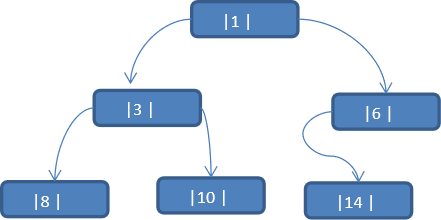
将数列{1, 3, 6, 8, 10, 14 } 构建成一颗二叉树. n+1=7
问题分析:
-
当我们对上面的二叉树进行中序遍历时,数列为{8, 3, 10, 1, 6, 14 }
-
但是6, 8, 10, 14 这几个节点的左右指针,并没有完全的利用上.
-
如果我们希望充分的利用各个节点的左右指针, 让各个节点可以指向自己的前后节点,怎么办?
-
解决方案-线索二叉树
02 线索二叉树基本介绍
- n 个结点的二叉链表中含有n+1 【公式2n-(n-1)=n+1】个空指针域。利用二叉链表中的空指针域,存放指向
该结点在某种遍历次序下的前驱和后继结点的指针(这种附加的指针称为"线索")
- 这种加上了线索的二叉链表称为线索链表,相应的二叉树称为线索二叉树(Threaded BinaryTree)。根据线索性质
的不同,线索二叉树可分为前序线索二叉树、中序线索二叉树和后序线索二叉树三种
-
一个结点的前一个结点,称为前驱结点
-
一个结点的后一个结点,称为后继结点
一、前序线索化
1.1 过程演示
1、按照前序遍历的顺序,第一个遍历到的节点是1,第二个遍历是3,期间pre为null不变。

2.继续遍历再到8,左指针为空,这里研究一下8节点:
8节点的左指针为空,所以令8节点的左指针指向它的前驱节点也就是3,并命pre指3,方便回溯的适合与node配合互指。
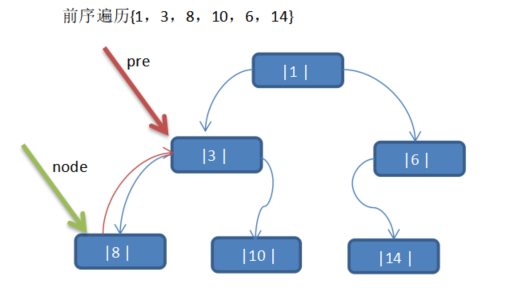
3.同时8节点的右节点也为空,判断父节点的右节点是否为空,若不为空则把后驱节点指向它,也就是10。
这里记得每次遍历 pre都会指向node,理解成往后面推进就行了。
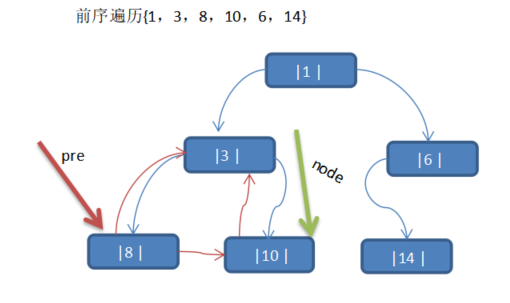
- 其实到这里代码基本敲完了,但后面大家可以打开debug一起走一遍完整的过程
4.节点10,左指针为空,将10的前驱节点设为pre,即3
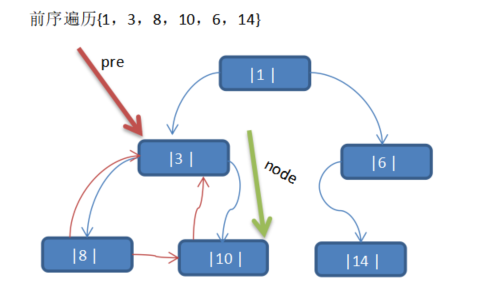
- node右遍历跑到6,pre右指针为空,将后驱节点指向node,即6。
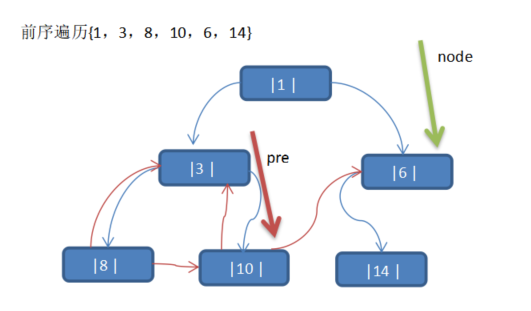
6.到14,pre右指针为空,,指向node。即14
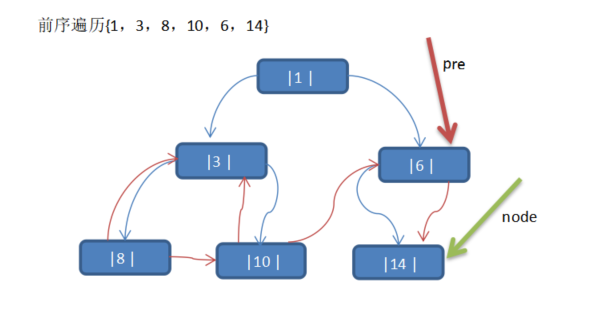
- 最后后移,node指向空,返回结束

1.2 代码实现:
1.2.1 编写对二叉树进行前序线索化的方法
//编写对二叉树进行前序线索化的方法
/**
* @param node 就是当前需要线索化的结点
*/
public void prethreadedNodes(HeroNode node) {
//如果node==null, 不能线索化
if (node == null) {
return;
}
//(一)线索化当前结点[有难度]
if (node.getLeft() == null) {
node.setLeft(pre);
node.setLeftType(1);
}
if (pre != null && pre.getRight() == null) {
pre.setRight(node);
pre.setRightType(1);
}
pre=node;
//(二)线索化左子树
if(node.getLeftType()!=1){
prethreadedNodes(node.getLeft());
}
//(三)线索化右子树
if(node.getRightType()!=1){
prethreadedNodes(node.getRight());
}
} //编写对二叉树进行前序线索化的方法
/**
* @param node 就是当前需要线索化的结点
*/
public void prethreadedNodes(HeroNode node) {
//如果node==null, 不能线索化
if (node == null) {
return;
}
//(一)线索化当前结点[有难度]
if (node.getLeft() == null) {
node.setLeft(pre);
node.setLeftType(1);
}
if (pre != null && pre.getRight() == null) {
pre.setRight(node);
pre.setRightType(1);
}
pre=node;
//(二)线索化左子树
infixthreadedNodes(node.getLeft());
//(三)线索化右子树
infixthreadedNodes(node.getRight());
}
1.2.2 前序线索化遍历
//前序线索化遍历
public void prethreadedList(){
HeroNode node =root;
while (node!=null){
if(node.getLeftType()==0){
System.out.println(node);
node=node.getLeft();
}
System.out.println(node);
node =node.getRight();
}
}
记得重载方法,关于测试代码等最下面附上。
1.3 运行结果:
10 号结点的前驱结点是=HeroNode [no=8, name=mary]
10 号结点的后继结点是=HeroNode [no=6, name=smith]
使用前序线索化的方式遍历线索化二叉树
HeroNode [no=1, name=tom]
HeroNode [no=3, name=jack]
HeroNode [no=8, name=mary]
HeroNode [no=10, name=king]
HeroNode [no=6, name=smith]
HeroNode [no=14, name=dim]
Process finished with exit code 0
二、中序线索化
2.1 过程演示

2.2 代码实现
//编写对二叉树进行中序线索化的方法
/**
尚硅谷Java 数据结构和算法
更多Java –大数据–前端–python 人工智能-区块链资料下载,可访问百度:尚硅谷官网第230页
*
* @param node 就是当前需要线索化的结点
*/
public void threadedNodes(HeroNode node) {
//如果node==null, 不能线索化
if(node == null) {
return;
}
//(一)先线索化左子树
threadedNodes(node.getLeft());
//(二)线索化当前结点[有难度]
//处理当前结点的前驱结点
//以8 结点来理解
//8 结点的.left = null , 8 结点的.leftType = 1
if(node.getLeft() == null) {
//让当前结点的左指针指向前驱结点
node.setLeft(pre);
//修改当前结点的左指针的类型,指向前驱结点
node.setLeftType(1);
}
//处理后继结点
if (pre != null && pre.getRight() == null) {
//让前驱结点的右指针指向当前结点
pre.setRight(node);
//修改前驱结点的右指针类型
pre.setRightType(1);
}
//!!! 每处理一个结点后,让当前结点是下一个结点的前驱结点
pre = node;
//(三)在线索化右子树
threadedNodes(node.getRight());
}
//中序遍历线索化二叉树的方法
public void threadedList() {
//定义一个变量,存储当前遍历的结点,从root 开始
HeroNode node = root;
while(node != null) {
//循环的找到leftType == 1 的结点,第一个找到就是8 结点
//后面随着遍历而变化,因为当leftType==1 时,说明该结点是按照线索化
//处理后的有效结点
while(node.getLeftType() == 0) {
node = node.getLeft();
}
//打印当前这个结点
System.out.println(node);
//如果当前结点的右指针指向的是后继结点,就一直输出
while(node.getRightType() == 1) {
//获取到当前结点的后继结点
node = node.getRight();
System.out.println(node);
}
//替换这个遍历的结点
node = node.getRight();
}
}
记得重载方法,关于测试代码等最下面附上。
2.3 运行结果
//测试中序线索二叉树的正确性
10 号结点的前驱结点是=HeroNode [no=3, name=jack]
10 号结点的后继结点是=HeroNode [no=1, name=tom]
使用线索化的方式遍历线索化二叉树
HeroNode [no=8, name=mary]
HeroNode [no=3, name=jack]
HeroNode [no=10, name=king]
HeroNode [no=1, name=tom]
HeroNode [no=14, name=dim]
HeroNode [no=6, name=smith]
//跟顺序存储二叉树中序遍历结果一致,正确!
三、后续线索化
3.1 过程演示略
附个效果图
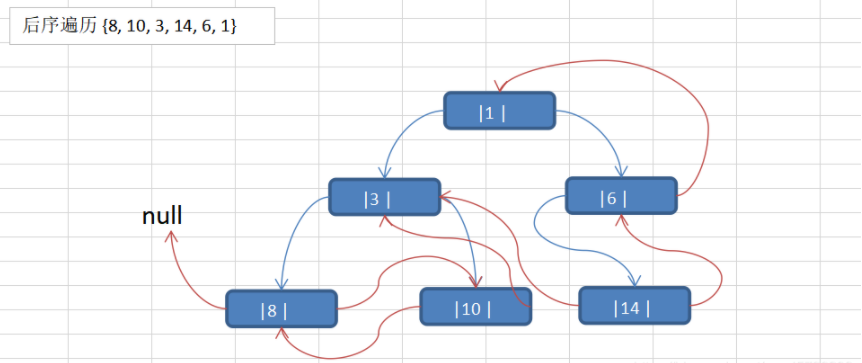
3.2 代码实现
//后序线索化遍历
public void postthreadedList(){
HeroNode node =root;
while (node!=null && node.getLeftType()!=1){
node =node.getLeft();
}
pre=null;
while (node!=null){
if(node.getRightType()==1){
System.out.println(node);
pre=node;
node=node.getRight();
}else {
if(node.getRight()==pre){
System.out.println(node);
if(node==root){
return;
}
pre=node;
node=root;
}else {
node=node.getRight();
while (node!=null&&node.getLeftType()!=1){
node=node.getLeft();
}
}
}
}
}
//编写对二叉树进行后续线索化的方法
/**
* @param node 就是当前需要线索化的结点
*/
public void lastthreadedNodes(HeroNode node) {
//如果node==null, 不能线索化
if (node == null) {
return;
}
//(一)线索化左子树
lastthreadedNodes(node.getLeft());
//(二)线索化右子树
lastthreadedNodes(node.getRight());
//(三)线索化当前结点[有难度]
if (node.getLeft() == null) {
node.setLeft(pre);
node.setLeftType(1);
}
if (pre != null && pre.getRight() == null) {
pre.setRight(node);
pre.setRightType(1);
}
pre=node;
}
记得重载方法,关于测试代码等最下面附上。
3.3 运行结果
10 号结点的前驱结点是=HeroNode [no=8, name=mary]
10 号结点的后继结点是=HeroNode [no=3, name=jack]
使用线索化的方式遍历线索化二叉树
HeroNode [no=8, name=mary]
HeroNode [no=10, name=king]
HeroNode [no=3, name=jack]
HeroNode [no=14, name=dim]
HeroNode [no=6, name=smith]
HeroNode [no=1, name=tom]
//跟顺序存储二叉树后序遍历结果一致,正确!
四、总代码
package tree.threadedBinaryTree;
import java.util.concurrent.SynchronousQueue;
public class ThreadedBinaryTreeDemo {
public static void main(String[] args) {
//测试一把中序线索二叉树的功能
HeroNode root = new HeroNode(1, "tom");
HeroNode node2 = new HeroNode(3, "jack");
HeroNode node3 = new HeroNode(6, "smith");
HeroNode node4 = new HeroNode(8, "mary");
HeroNode node5 = new HeroNode(10, "king");
HeroNode node6 = new HeroNode(14, "dim");
//二叉树,后面我们要递归创建, 现在简单处理使用手动创建
root.setLeft(node2);
root.setRight(node3);
node2.setLeft(node4);
node2.setRight(node5);
node3.setLeft(node6);
//测试线索化
ThreadedBinaryTree threadedBinaryTree = new ThreadedBinaryTree();
threadedBinaryTree.setRoot(root);
threadedBinaryTree.prethreadedNodes();
//测试: 以10 号节点测试
HeroNode leftNode = node5.getLeft();
HeroNode rightNode = node5.getRight();
System.out.println("10 号结点的前驱结点是=" + leftNode); //3
System.out.println("10 号结点的后继结点是=" + rightNode); //1
//当线索化二叉树后,能在使用原来的遍历方法
//threadedBinaryTree.infixOrder();
// System.out.println("使用中序线索化的方式遍历线索化二叉树");
// threadedBinaryTree.threadedList(); // 8, 3, 10, 1, 14, 6
System.out.println("使用前序线索化的方式遍历线索化二叉树");
threadedBinaryTree.prethreadedList();//1,3,8,10,6,14
// System.out.println("使用后序线索化的方式遍历线索化二叉树");
// threadedBinaryTree.prethreadedList();//8,10,3,14,6,1
}
}
//定义ThreadedBinaryTree 实现了线索化功能的二叉树
class ThreadedBinaryTree {
private HeroNode root;
//为了实现线索化,需要创建要给指向当前结点的前驱结点的指针
//在递归进行线索化时,pre 总是保留前一个结点
private HeroNode pre = null;
public void setRoot(HeroNode root) {
this.root = root;
}
//重载一把threadedNodes 方法
public void threadedNodes() {
this.threadedNodes(root);
}
public void prethreadedNodes(){ this.prethreadedNodes(root);}
public void lastthreadedNodes(){ this.lastthreadedNodes(root);}
//中序遍历线索化二叉树的方法
public void threadedList() {
//定义一个变量,存储当前遍历的结点,从root 开始
HeroNode node = root;
while(node != null) {
//循环的找到leftType == 1 的结点,第一个找到就是8 结点
//后面随着遍历而变化,因为当leftType==1 时,说明该结点是按照线索化
//处理后的有效结点
while(node.getLeftType() == 0) {
node = node.getLeft();
}
//打印当前这个结点
System.out.println(node);
//如果当前结点的右指针指向的是后继结点,就一直输出
while(node.getRightType() == 1) {
//获取到当前结点的后继结点
node = node.getRight();
System.out.println(node);
}
//替换这个遍历的结点
node = node.getRight();
}
}
//编写对二叉树进行中序线索化的方法
/**
尚硅谷Java 数据结构和算法
更多Java –大数据–前端–python 人工智能-区块链资料下载,可访问百度:尚硅谷官网第230页
*
* @param node 就是当前需要线索化的结点
*/
public void threadedNodes(HeroNode node) {
//如果node==null, 不能线索化
if(node == null) {
return;
}
//(一)先线索化左子树
threadedNodes(node.getLeft());
//(二)线索化当前结点[有难度]
//处理当前结点的前驱结点
//以8 结点来理解
//8 结点的.left = null , 8 结点的.leftType = 1
if(node.getLeft() == null) {
//让当前结点的左指针指向前驱结点
node.setLeft(pre);
//修改当前结点的左指针的类型,指向前驱结点
node.setLeftType(1);
}
//处理后继结点
if (pre != null && pre.getRight() == null) {
//让前驱结点的右指针指向当前结点
pre.setRight(node);
//修改前驱结点的右指针类型
pre.setRightType(1);
}
//!!! 每处理一个结点后,让当前结点是下一个结点的前驱结点
pre = node;
//(三)在线索化右子树
threadedNodes(node.getRight());
}
//编写对二叉树进行前序线索化的方法
/**
* @param node 就是当前需要线索化的结点
*/
public void prethreadedNodes(HeroNode node) {
//如果node==null, 不能线索化
if (node == null) {
return;
}
//(一)线索化当前结点[有难度]
if (node.getLeft() == null) {
node.setLeft(pre);
node.setLeftType(1);
}
if (pre != null && pre.getRight() == null) {
pre.setRight(node);
pre.setRightType(1);
}
pre=node;
//(二)线索化左子树
if(node.getLeftType()!=1){
prethreadedNodes(node.getLeft());
}
//(三)线索化右子树
if(node.getRightType()!=1){
prethreadedNodes(node.getRight());
}
}
//前序线索化遍历
public void prethreadedList(){
HeroNode node =root;
while (node!=null){
if(node.getLeftType()==0){
System.out.println(node);
node=node.getLeft();
}
System.out.println(node);
node =node.getRight();
}
}
//编写对二叉树进行后续线索化的方法
/**
* @param node 就是当前需要线索化的结点
*/
public void lastthreadedNodes(HeroNode node) {
//如果node==null, 不能线索化
if (node == null) {
return;
}
//(一)线索化左子树
lastthreadedNodes(node.getLeft());
//(二)线索化右子树
lastthreadedNodes(node.getRight());
//(三)线索化当前结点[有难度]
if (node.getLeft() == null) {
node.setLeft(pre);
node.setLeftType(1);
}
if (pre != null && pre.getRight() == null) {
pre.setRight(node);
pre.setRightType(1);
}
pre=node;
}
//后序线索化遍历
public void postthreadedList(){
HeroNode node =root;
while (node!=null && node.getLeftType()!=1){
node =node.getLeft();
}
pre=null;
while (node!=null){
if(node.getRightType()==1){
System.out.println(node);
pre=node;
node=node.getRight();
}else {
if(node.getRight()==pre){
System.out.println(node);
if(node==root){
return;
}
pre=node;
node=root;
}else {
node=node.getRight();
while (node!=null&&node.getLeftType()!=1){
node=node.getLeft();
}
}
}
}
}
//删除结点
public void delNode(int no) {
if(root != null) {
//如果只有一个root 结点, 这里立即判断root 是不是就是要删除结点
if(root.getNo() == no) {
root = null;
} else {
//递归删除
root.delNode(no);
}
}else{
System.out.println("空树,不能删除~");
}
}
//前序遍历
public void preOrder() {
if(this.root != null) {
this.root.preOrder();
}else {
System.out.println("二叉树为空,无法遍历");
}
}
//中序遍历
public void infixOrder() {
if(this.root != null) {
this.root.infixOrder();
}else {
System.out.println("二叉树为空,无法遍历");
}
}
//后序遍历
public void postOrder() {
if(this.root != null) {
this.root.postOrder();
}else {
System.out.println("二叉树为空,无法遍历");
}
}
//前序遍历
public HeroNode preOrderSearch(int no) {
if(root != null) {
return root.preOrderSearch(no);
} else {
return null;
}
}
//中序遍历
public HeroNode infixOrderSearch(int no) {
if(root != null) {
return root.infixOrderSearch(no);
}else {
return null;
}
}
//后序遍历
public HeroNode postOrderSearch(int no) {
if(root != null) {
return this.root.postOrderSearch(no);
}else {
return null;
}
}
}
//先创建HeroNode 结点
class HeroNode {
private int no;
private String name;
private HeroNode left; //默认null
private HeroNode right; //默认null
//说明
//1. 如果leftType == 0 表示指向的是左子树, 如果1 则表示指向前驱结点
//2. 如果rightType == 0 表示指向是右子树, 如果1 表示指向后继结点
private int leftType;
private int rightType;
public int getLeftType() {
return leftType;
}
public void setLeftType(int leftType) {
this.leftType = leftType;
}
public int getRightType() {
return rightType;
}
public void setRightType(int rightType) {
this.rightType = rightType;
}
public HeroNode(int no, String name) {
this.no = no;
this.name = name;
}
public int getNo() {
return no;
}
public void setNo(int no) {
this.no = no;
}
public String getName() {
return name;
}
public void setName(String name) {
this.name = name;
}
public HeroNode getLeft() {
return left;
}
public void setLeft(HeroNode left) {
this.left = left;
}
public HeroNode getRight() {
return right;
}
public void setRight(HeroNode right) {
this.right = right;
}
@Override
public String toString() {
return "HeroNode [no=" + no + ", name=" + name + "]";
}
//递归删除结点
//1.如果删除的节点是叶子节点,则删除该节点
//2.如果删除的节点是非叶子节点,则删除该子树
public void delNode(int no) {
//思路
/*
* 1. 因为我们的二叉树是单向的,所以我们是判断当前结点的子结点是否需要删除结点,而不能去判断
当前这个结点是不是需要删除结点.
2. 如果当前结点的左子结点不为空,并且左子结点就是要删除结点,就将this.left = null; 并且就返回
(结束递归删除)
3. 如果当前结点的右子结点不为空,并且右子结点就是要删除结点,就将this.right= null ;并且就返回
(结束递归删除)
4. 如果第2 和第3 步没有删除结点,那么我们就需要向左子树进行递归删除
5. 如果第4 步也没有删除结点,则应当向右子树进行递归删除.
*/
//2. 如果当前结点的左子结点不为空,并且左子结点就是要删除结点,就将this.left = null; 并且就返回(结束递归删除)
if(this.left != null && this.left.no == no) {
this.left = null;
return;
}
//3.如果当前结点的右子结点不为空,并且右子结点就是要删除结点,就将this.right= null ;并且就返回(结束递归删除)
if(this.right != null && this.right.no == no) {
this.right = null;
return;
}
//4.我们就需要向左子树进行递归删除
if(this.left != null) {
this.left.delNode(no);
}
//5.则应当向右子树进行递归删除
if(this.right != null) {
this.right.delNode(no);
}
}
//编写前序遍历的方法
public void preOrder() {
System.out.println(this); //先输出父结点
//递归向左子树前序遍历
if(this.left != null) {
this.left.preOrder();
}
//递归向右子树前序遍历
if(this.right != null) {
this.right.preOrder();
}
}
//中序遍历
public void infixOrder() {
//递归向左子树中序遍历
if(this.left != null) {
this.left.infixOrder();
}
//输出父结点
System.out.println(this);
//递归向右子树中序遍历
if(this.right != null) {
this.right.infixOrder();
}
}
//后序遍历
public void postOrder() {
if(this.left != null) {
this.left.postOrder();
}
if(this.right != null) {
this.right.postOrder();
}
System.out.println(this);
}
//前序遍历查找
/**
*
* @param no 查找no
* @return 如果找到就返回该Node ,如果没有找到返回null
*/
public HeroNode preOrderSearch(int no) {
System.out.println("进入前序遍历");
//比较当前结点是不是
if(this.no == no) {
return this;
}
//1.则判断当前结点的左子节点是否为空,如果不为空,则递归前序查找
//2.如果左递归前序查找,找到结点,则返回
HeroNode resNode = null;
if(this.left != null) {
resNode = this.left.preOrderSearch(no);
}
if(resNode != null) {//说明我们左子树找到
return resNode;
}
//1.左递归前序查找,找到结点,则返回,否继续判断,
//2.当前的结点的右子节点是否为空,如果不空,则继续向右递归前序查找
if(this.right != null) {
resNode = this.right.preOrderSearch(no);
}
return resNode;
}
//中序遍历查找
public HeroNode infixOrderSearch(int no) {
//判断当前结点的左子节点是否为空,如果不为空,则递归中序查找
HeroNode resNode = null;
if(this.left != null) {
resNode = this.left.infixOrderSearch(no);
}
if(resNode != null) {
return resNode;
}
System.out.println("进入中序查找");
//如果找到,则返回,如果没有找到,就和当前结点比较,如果是则返回当前结点
if(this.no == no) {
return this;
}
//否则继续进行右递归的中序查找
if(this.right != null) {
resNode = this.right.infixOrderSearch(no);
}
return resNode;
}
//后序遍历查找
public HeroNode postOrderSearch(int no) {
//判断当前结点的左子节点是否为空,如果不为空,则递归后序查找
HeroNode resNode = null;
if(this.left != null) {
resNode = this.left.postOrderSearch(no);
}
if(resNode != null) {//说明在左子树找到
return resNode;
}
//如果左子树没有找到,则向右子树递归进行后序遍历查找
if(this.right != null) {
resNode = this.right.postOrderSearch(no);
}
if(resNode != null) {
return resNode;
}
System.out.println("进入后序查找");
//如果左右子树都没有找到,就比较当前结点是不是
if(this.no == no) {
return this;
}
return resNode;
}
}
























 1万+
1万+











 被折叠的 条评论
为什么被折叠?
被折叠的 条评论
为什么被折叠?










